Recapping ‘The Jetsons’: Episode 04 – The Coming of Astro
Man’s best friend has been fending off the the threat of a robot replacement for decades, not just on television

Astro and the robot dog ‘Lectronimo with George Jetson (screenshot from “The Coming of Astro”)
This is the fourth in a 24-part series looking at every episode of “The Jetsons” TV show from the original 1962-63 season.
The fourth episode of “The Jetsons” originally aired on October 14, 1962 and was titled “The Coming of Astro.”
After Elroy brings home a dog and convinces his mother Jane to let him keep it, the family makes their case for getting a dog to George over the videophone. George isn’t too keen on getting a dog, but wants to keep the peace within his family.
George consults the company computer to figure out what he should do about his family’s desire for a dog. The computer suggests an electronic dog, which George sees as a wonderful solution since it has benefits like, “no feeding, no bathing, no fleas.” George makes his way to the local pet shop and buys a dog named ‘Lectronimo, a nuclear-powered pet with a penchant for biting thieves. Upon arriving home with his pushy pooch, George discovers that the family already has a dog named Astro — the flesh and blood puppy that Elroy brought home. George pits Astro against the robot dog in various doggie aptitude tests to determine which dog the Jetson family will keep. In the end, the Jetsons of course choose to keep Astro and donate their nuclear-powered electronic dog to the police force.
Naturally, the robot dog predates The Jetsons’ representation of the mechanical mutt by many decades. The oldest “electric dog” that I’ve been able to find in my archive comes from the September 1923 issue of Practical Electrics magazine, a hobbyist magazine of the 1920s. The cover shows a man leading an “electric dog” by a cane while a woman and boy look on.
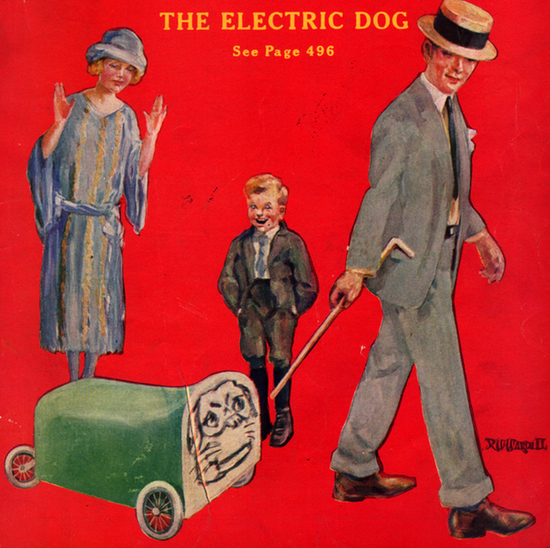
An electric dog from the September 1923 issue of Practical Electrics magazine
The accompanying article explained how to make your own electric dog. The magnetic cane directs movement, but the electric dog is actually self-propelled, as you can see from the illustration below.
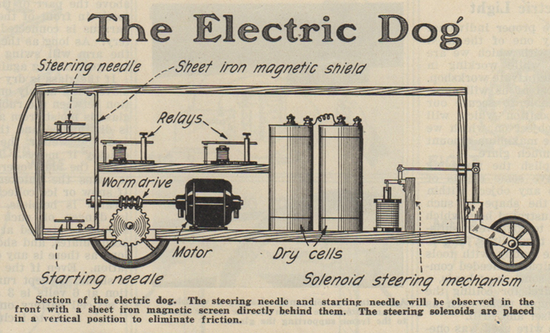
Sectional view of the electric dog from the September 1923 issue of Practical Electrics magazine
Just a few years after the Practical Electrics cover, a short item from the Associated Press told of a robot dog in Paris that could follow the directions of its inventor by way of light. From the November 24, 1929 Florence Morning News in Florence, South Carolina:
A robot dog that walks and barks is amusing Paris. Selenium cells in the eyes actuate motors that turn little wheels in the paws and a horn supplies the bark.
A flashlight directed at the eyes controls the various mechanisms. Held to one side, so one eye gets more light than the other, the paw-wheels on the opposite side move, causing the dog to follow the light. If both eyes are illuminated equally the dog advances straight forward.
An increase in the light causes barking.
In contrast, ‘Lectronimo’s barking appears to be caused by a “robber’s mask” which naturally, every robber of the future wears.
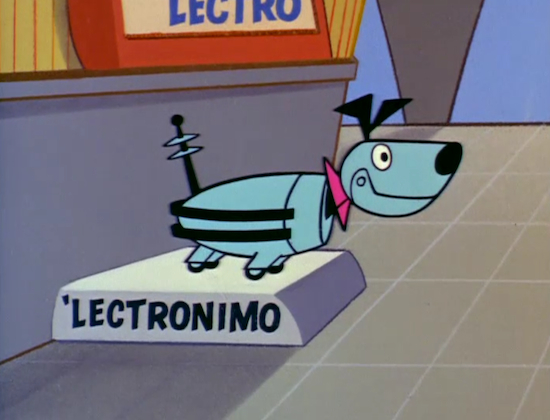
Screenshot of ‘Lectronimo the nuclear-powered dog of the future
There’s no denying that ‘Lectronimo was clearly inspired by a robotic dog named Sparko, built by Westinghouse engineers in 1940.
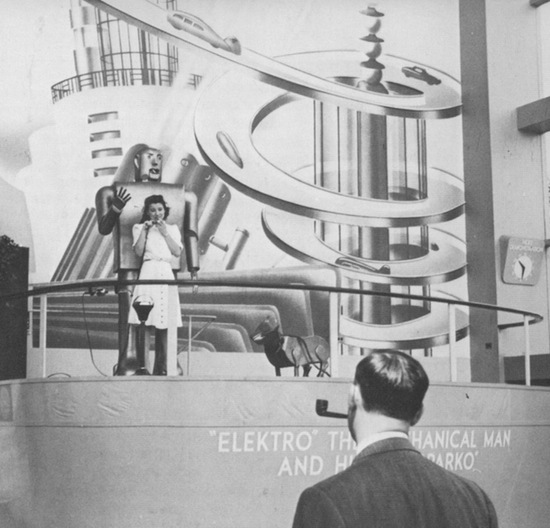
Sparko and Elektro at the 1940 NY World’s Fair (image source: Dawn of a New Day by The Queens Museum, 1980)
Sparko was built after the massive success of another Westinghouse robot named Elektro, which took the 1939 New York World’s Fair by storm. At 65 pounds and about two feet tall, Sparko was built as Elektro’s best friend. And like Elektro, there were many variations of him (three by some counts) used by Westinghouse in the 1940s and ’50s for various promotional purposes. After his appearance at the 1940 New York World’s Fair it’s likely Sparko took a break from promotional activities on account of WWII. But Sparko came back with a vengeance after the war, helping Elektro and Westinghouse hawk as many washers, dryers and refrigerators as possible.
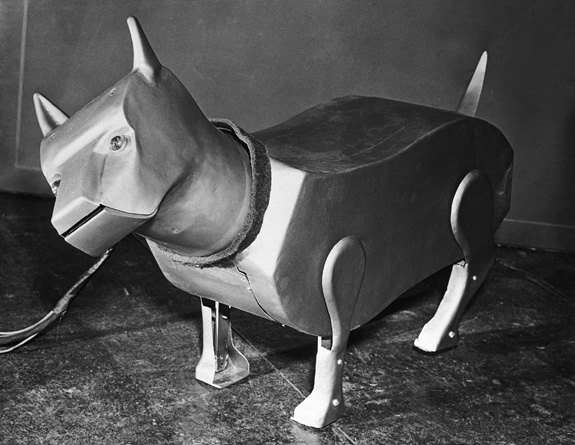
Sparko, the world’s first electrical dog, as he looked on arrival at the engineer’s club, New York City, on his way to the World’s fair, where he was be an attraction at the Westinghouse Building. Credit: (c) Bettman/Corbis
When Sparko came out of semi-retirement after WWII he was used to promote appliances at home and garden shows and retail outlets all across the U.S. The photo below comes from the May 26, 1951 edition of the Wisconsin State Journal in Madison, Wisconsin.
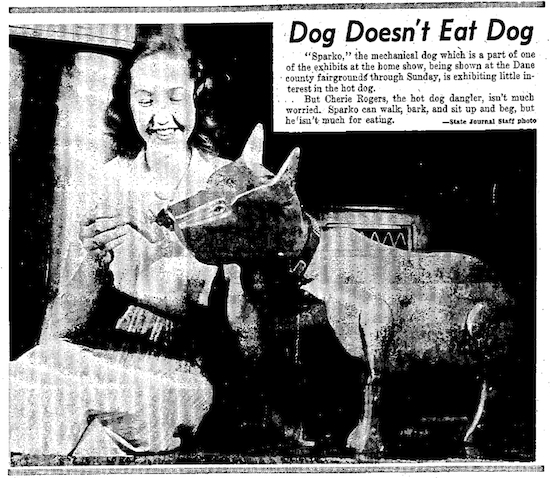
Photo of Sparko the robot dog in the May 26, 1951 Wisconsin State Journal (Madison, WI)
Ads would run in various newspapers, explaining the imminent arrival of Elektro and Sparko. The ad below comes from the July 25, 1956 Port Angeles Evening Times in Port Angeles, Washington and claims that if you correctly guess the number of feet of wire in Elektro and Sparko you’ll win a free Westinghouse dryer.
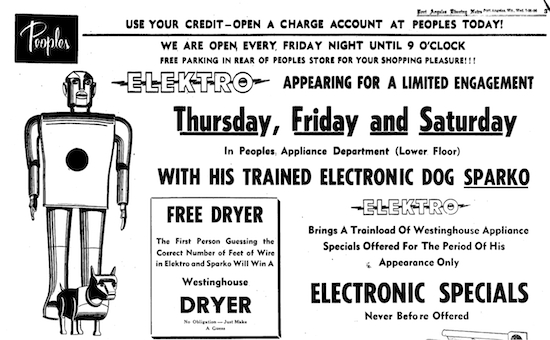
Elektro and Sparko in an ad from the July 25, 1956 Port Angeles Evening News (Port Angeles, WA)
The robot dog so many Americans had come to know in Sparko is shown to exist in the Jetsons world, but is ultimately rejected. In an effort to make the show relatable — to allow the people of 1962 to project themselves into the future along with the Jetson family — we spend most of the series not with robo-dogs but with Astro, a goofy and lovable dog that’s far more sympathetic than a cold metal canine. Like so many of the implicit promises of the Jetsons universe, this was an assurance to viewers of the 1960s that some wonderful technological changes would take place a hundred years hence, but your favorite cuddly things (like the family dog) will still be intact.
If Astro’s voice sounds familiar to another famous cartoon dog, that’s probably because Astro was voiced by Don Messick who would later do the voice of Scooby-Doo.
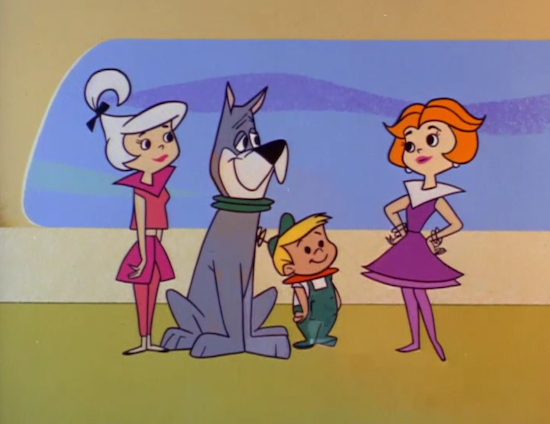
Astro and the Jetson family in a screenshot from the fourth episode of The Jetsons in 1962
Today, there are a number of different people studying the way in which we interact with robotic pets. A 2004 study in Australia looked at the way that children and adults interacted with Sony’s robot dog Aibo. They found that children saw the robot dog as a pet first, and a machine second; whereas adults saw the inverse — a machine that happens to be a pet.
DARPA’s development of “pack mules” (which years ago they used to call “dogs) may point to the kind of dexterity that future robot pets could exhibit. But for now, robotic pets aren’t yet a reality for most families. Maybe that’s because the technology isn’t quite yet advanced or “lifelike” enough. Or maybe that’s because the Jetsons promised us Astro, not ‘Lectronimo.
/https://tf-cmsv2-smithsonianmag-media.s3.amazonaws.com/accounts/headshot/matt-novak-240.jpg)

/https://tf-cmsv2-smithsonianmag-media.s3.amazonaws.com/accounts/headshot/matt-novak-240.jpg)